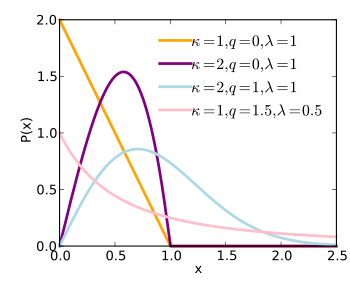
Summary
In statistics, the q-Weibull distribution is a probability distribution that generalizes the Weibull distribution and the Lomax distribution (Pareto Type II). It is one example of a Tsallis distribution.
|
Probability density function  | |||
|
Cumulative distribution function  | |||
| Parameters |
shape (real) rate (real) shape (real) | ||
|---|---|---|---|
| Support |
| ||
| CDF | |||
| Mean | (see article) | ||
Characterization edit
Probability density function edit
The probability density function of a q-Weibull random variable is:[1]
where q < 2, > 0 are shape parameters and λ > 0 is the scale parameter of the distribution and
is the q-exponential[1][2][3]
Cumulative distribution function edit
The cumulative distribution function of a q-Weibull random variable is:
where
Mean edit
The mean of the q-Weibull distribution is
where is the Beta function and is the Gamma function. The expression for the mean is a continuous function of q over the range of definition for which it is finite.
Relationship to other distributions edit
The q-Weibull is equivalent to the Weibull distribution when q = 1 and equivalent to the q-exponential when
The q-Weibull is a generalization of the Weibull, as it extends this distribution to the cases of finite support (q < 1) and to include heavy-tailed distributions .
The q-Weibull is a generalization of the Lomax distribution (Pareto Type II), as it extends this distribution to the cases of finite support and adds the parameter. The Lomax parameters are:
As the Lomax distribution is a shifted version of the Pareto distribution, the q-Weibull for is a shifted reparameterized generalization of the Pareto. When q > 1, the q-exponential is equivalent to the Pareto shifted to have support starting at zero. Specifically:
See also edit
References edit
- ^ a b Picoli, S. Jr.; Mendes, R. S.; Malacarne, L. C. (2003). "q-exponential, Weibull, and q-Weibull distributions: an empirical analysis". Physica A: Statistical Mechanics and Its Applications. 324 (3): 678–688. arXiv:cond-mat/0301552. Bibcode:2003PhyA..324..678P. doi:10.1016/S0378-4371(03)00071-2. S2CID 119361445.
- ^ Naudts, Jan (2010). "The q-exponential family in statistical physics". Journal of Physics: Conference Series. 201 (1): 012003. arXiv:0911.5392. Bibcode:2010JPhCS.201a2003N. doi:10.1088/1742-6596/201/1/012003. S2CID 119276469.
- ^ Umarov, Sabir; Tsallis, Constantino; Steinberg, Stanly (2008). "On a q-Central Limit Theorem Consistent with Nonextensive Statistical Mechanics" (PDF). Milan Journal of Mathematics. 76: 307–328. doi:10.1007/s00032-008-0087-y. S2CID 55967725. Retrieved 9 June 2014.









